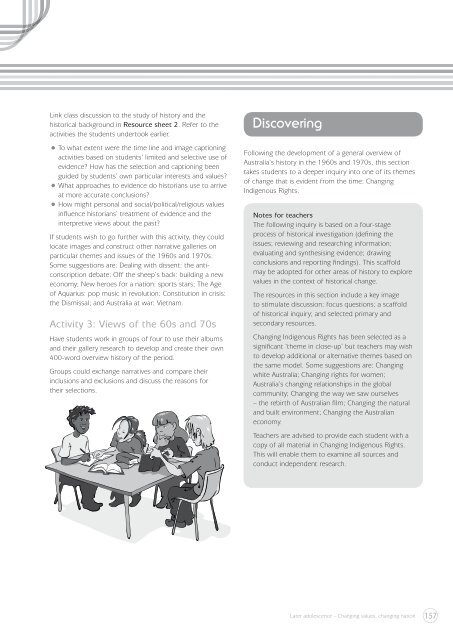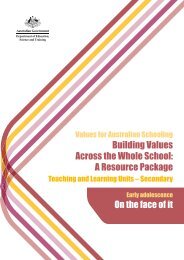Changing values, changing nation - Saint Ignatius' Moodle Community
Changing values, changing nation - Saint Ignatius' Moodle Community
Changing values, changing nation - Saint Ignatius' Moodle Community
Create successful ePaper yourself
Turn your PDF publications into a flip-book with our unique Google optimized e-Paper software.
Link class discussion to the study of history and the<br />
historical background in Resource sheet 2. Refer to the<br />
activities the students undertook earlier.<br />
• To what extent were the time line and image captioning<br />
activities based on students’ limited and selective use of<br />
evidence? How has the selection and captioning been<br />
guided by students’ own particular interests and <strong>values</strong>?<br />
• What approaches to evidence do historians use to arrive<br />
at more accurate conclusions?<br />
• How might personal and social/political/religious <strong>values</strong><br />
influence historians’ treatment of evidence and the<br />
interpretive views about the past?<br />
If students wish to go further with this activity, they could<br />
locate images and construct other narrative galleries on<br />
particular themes and issues of the 1960s and 1970s.<br />
Some suggestions are: Dealing with dissent: the anticonscription<br />
debate; Off the sheep’s back: building a new<br />
economy; New heroes for a <strong>nation</strong>: sports stars; The Age<br />
of Aquarius: pop music in revolution; Constitution in crisis:<br />
the Dismissal; and Australia at war: Vietnam.<br />
Activity 3: Views of the 60s and 70s<br />
Have students work in groups of four to use their albums<br />
and their gallery research to develop and create their own<br />
400-word overview history of the period.<br />
Groups could exchange narratives and compare their<br />
inclusions and exclusions and discuss the reasons for<br />
their selections.<br />
Discovering<br />
Following the development of a general overview of<br />
Australia’s history in the 1960s and 1970s, this section<br />
takes students to a deeper inquiry into one of its themes<br />
of change that is evident from the time: <strong>Changing</strong><br />
Indigenous Rights.<br />
Notes for teachers<br />
The following inquiry is based on a four-stage<br />
process of historical investigation (defining the<br />
issues; reviewing and researching information;<br />
evaluating and synthesising evidence; drawing<br />
conclusions and reporting findings). This scaffold<br />
may be adopted for other areas of history to explore<br />
<strong>values</strong> in the context of historical change.<br />
The resources in this section include a key image<br />
to stimulate discussion; focus questions; a scaffold<br />
of historical inquiry; and selected primary and<br />
secondary resources.<br />
<strong>Changing</strong> Indigenous Rights has been selected as a<br />
significant ‘theme in close-up’ but teachers may wish<br />
to develop additional or alternative themes based on<br />
the same model. Some suggestions are: <strong>Changing</strong><br />
white Australia; <strong>Changing</strong> rights for women;<br />
Australia’s <strong>changing</strong> relationships in the global<br />
community; <strong>Changing</strong> the way we saw ourselves<br />
– the rebirth of Australian film; <strong>Changing</strong> the natural<br />
and built environment; <strong>Changing</strong> the Australian<br />
economy.<br />
Teachers are advised to provide each student with a<br />
copy of all material in <strong>Changing</strong> Indigenous Rights.<br />
This will enable them to examine all sources and<br />
conduct independent research.<br />
Later adolescence – <strong>Changing</strong> <strong>values</strong>, <strong>changing</strong> <strong>nation</strong><br />
157







